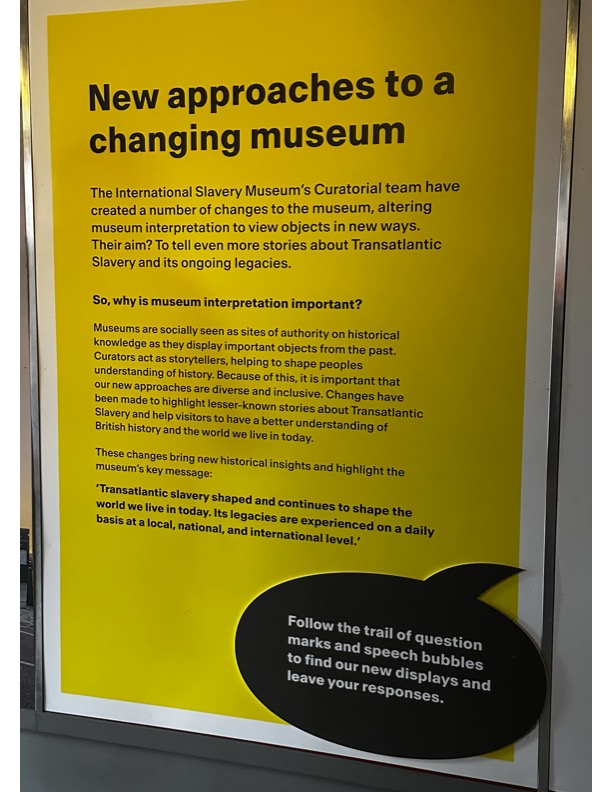» Day 2—Part 2: So Many Layers . . . the International Slavery Museum (ISM)
This is the third blog post in a series written by Georgette Mayo, Avery Research Center’s Processing Archivist, reflecting on her trip to London and Liverpool in October 2024.
“It always requires a certain courage to speak the unspeakable.” – Moana Jackson, Māori lawyer

Before this UK trip, I assumed the International Slavery Museum (ISM) was housed in a separate free-standing building. To my surprise, it occupies the third floor of the Merseyside Maritime Museum. Yet it is “the only museum in the world dedicated to the transatlantic slave trade.”1 The museum will close to the public on January 5, 2025, to start its redevelopment project.
Miles Greenwood, the museum’s lead curator, greeted our delegation. He began his talk with a disclaimer: “If this is too much, you can take a break or leave the tour entirely.” Greenwood stressed to everyone to “take care of yourself.” This was especially true for the “Enslavement and the Middle Passage” gallery.

As we walked through the expansive exhibit, Greenwood mentioned what he anticipated the museum’s revised narrative would be. He thoughtfully critiqued what prior curators created and what they got wrong and correct in their narrative. Greenwood aims to build and clarify certain aspects of the new installations with the museum expansion. The middle ground and precursor of things to come can be found in the Challenging Histories: Collecting New Artworks permanent exhibit.

A combination of original artifacts, artwork, and text panels expose the atrocities and complexities of the transatlantic trade experience and enslavement. Originally, Liverpool was a fishing village and was not involved in early British slaving. Due to Liverpool’s access to nearby rivers and canals, the town initially traded cloth, guns, and iron. By the 1780s, Liverpool’s port access led them to dominate the transportation of enslaved Africans, thus becoming the European capital of the transatlantic slave trade. Vast profits from the trade transformed Liverpool into one of Britain’s most essential and wealthy cities. The city was responsible for the passage of nearly 1.5 million Africans into slavery—more than 10% of all known Africans transported.”2
Several artifacts that caught my attention and that I questioned were “commemorative” bowls and plates awarding ship captains at the onset or completion of a successful voyage in transporting the enslaved to their destinations. These “tributes” for a job well done unnerved me. You can view these bowls here because I neglected to capture an image.3 Jane Webster’s article “Success to the Dobson’: Commemorative Artefacts Depicting the 18th-Century British Slave Ships” provides an in-depth analysis of these artifacts.
I thought about Greenwood’s initial concern about our mental state from the absorption of enslavement’s horrors. In turn, I asked him how he handles his mental stability while constantly interpreting complex history. His immediate reply was one word: “Therapy.” Greenwood added that he continually checks in with his colleagues to ensure they are stable. He further stated he does not want visitors to experience guilt. “Your guilt is not going to help me.”
Because the mental health of GLAM professionals (galleries, libraries, archives museums) is a serious issue, I will leave two links that address this concern:
- The Impact of Curating Traumatic Histories by Emma King Consultancy
- Supporting the Mental Health of Museum Staff from the American Alliance of Museums
Footnotes
- “About the museum,” International Slavery Museum. https://www.liverpoolmuseums.org.uk/international-slavery-museum/about#section–frequently-asked-questions Accessed 6 December 2024. ↩︎
- “Liverpool: capital of the transatlantic slave trade.” Exhibit panel from International Slavery Museum, Liverpool, United Kingdom. From image taken 13 October 2024. and “About the museum: Frequently asked questions.” International Slavery Museum, National Museums Liverpool, https://www.liverpoolmuseums.org.uk/international-slavery-museum/about#section–frequently-asked-questions. Accessed 6 December 2024. ↩︎
- Webster, Jane. “‘Success to the Dobson’: Commemorative artefacts depicting 18th-century British slave ships.” Post-Medieval Archaeology, vol. 49, no. 1, June 2015, pp. 72–98, https://doi.org/10.1179/0079423615z.00000000072. Accessed 2 December 2024. ↩︎
Image Credit
- Georgette Mayo, “International Slavery Museum ‘We will remember,'” personal photograph.
- Ibid., “Miles Greenwood ISM lead curator,” personal photograph.
- Ibid., “New approaches to a changing museum,” personal photograph.
